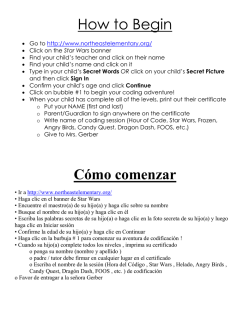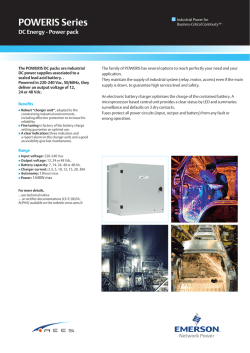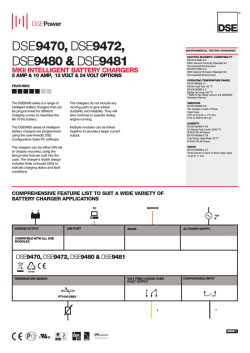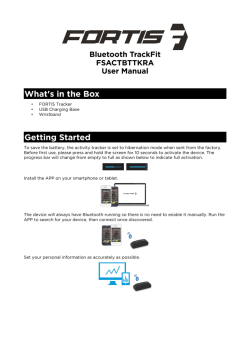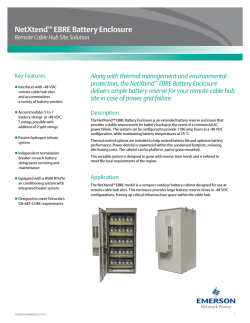
CAOS330 Setup
Illustrated Assembly Manual V1.1 CAOS 330 Assembly Manual of the RJX CAOS 330 For the correct assembly and safe flying of your RJX CAOS 330 Model, this manual uses this symbol where special attention is required. Failing to carry out the instructions at this point in the assembly will result in an electronic and/or mechanical failure or possible injury. HOW TO USE THIS INSTRUCTION MANUAL This manual contains the detailed instructions to build and set up the RJX CAOS 330. Please follow it to ensure that you achieve the best performance and mechanical integrity from your finished kit. For those of you who already have experience with model helicopters, we strongly suggest that you assemble and adjust your model according to these instructions for the best results. Please keep this manual in a safe place and refer to it when replacing spare parts or upgrading. DISCLAIMER While every effort has been made to supply the proper information in this manual, the Manufacturer and Distributor cannot guarantee that the consumer will interpret or follow these instructions as intended and therefore the Manufacturer and Distributor cannot assume any liability for damage or claims occurring from the misuse of our product. Beginners are encouraged to seek help from an experienced pilot to assist in the first test flights. We encourage you to practice frequently and enjoy the experience of RC rotary flight! WARNING LiPo batteries need special care. Improper storage, handling or charging may cause fire or damage your Helicopter and possibly to yourself. Contact your dealer or supplier for more information. 1. Check your charger settings before charging your LiPo battery to insure they are correct for the specifications of the battery. 2. We recommend storing and charging LiPo batteries in a Lipo sack or porcelain container. If kept in a metal container or ammo case, the batteries may explode if the storage containers are sealed and the gases are not able to vent. We recommend using the original Lipo Sack from the USA since it was designed to contain the jet flames discharged from a failing Lipo battery. 3. Please keep LiPo Batteries away from sources of heat. 4. Never store LiPo Batteries fully charged. 5. NEVER SHORT CUT LiPo Battery wires. 6. Before connecting your LiPo battery to the Helicopter, make sure your transmitter is turned ON and all sticks and switches are set properly. This product is intended for advanced users. It may look easy when watching an experienced pilot flying his model, but it takes dedication and numerous hours of practice to be able to operate this model safely and efficiently. Page 002 TO PREVENT LOOSE SCREWS AND BOLTS Items required to complete the RJX CAOS 330 Regardless how tightly nuts, bolts and screws are tightened, they slowly loosen over time due to vibration of the helicopter. Should this happen, you will lose control of the helicopter which may cause severe damages or very potential dangerous situation. - PCM or 2,4 Ghz Radio System - CC3D or NAZE 32 Control Board - 4x 1806-2207 Type 2000-2200 kV Brushless Out runner Motor - LiPo Pack 3S- 6S 1300 up to 2200 mAh (depending on setup) - 4x 10A-30A ESC (if not delivered) - 5x3 – 6x4,5 CW/CCW or 3D Propeller - LiPo Charger We strongly recommend that you apply thread lock to any nuts, bolts or screws. There are two types of thread lock, blue (medium) and red (hard). Clean the nuts, bolts and screws with Alcohol (or similar) before you apply the thread lock. Use blue thread lock on screws that have to be removed regularly, and Red thread lock for screws that should be fixed permanently. Tools required (not included) - Allen Drivers 1,5 mm - 2 mm - 2,5 mm - 3 mm - 4 mm - Philips Drivers large - middle - small - Nut Drivers 4,5 mm - 5,5 mm - 7 mm - Cutter - Universal Pliers - Sandpaper - Cyanoacrylate (CA - Superglue) 1. Use CA: (Super glue or similar) at this point 2. LOCTIDE 243blue ( ) - LOCTIDE 648 (red): Remove oil and grease then apply shown thread lock. (This applies throughout the manual) 3. GREASE: Remove oil and grease. (This applies throughout the manual) Page 003 STEP 001 Page 004 STEP 002 Page 005 STEP 003 Cut the edges carefully Page 006 STEP 004 Page 007 STEP 005 Page 008 STEP 006 Page 009 STEP 007 Page 010 STEP 008 Page 011 STEP 009 Page 012 STEP 010 Page 013 STEP 011 Page 014 STEP 012 Page 015 STEP 013 Page 016 STEP 014 Page 017 STEP 015 Page 018 STEP 016 Page 019 STEP 017 Page 020 STEP 018 Page 021 STEP 019 Page 022 STEP 020 Page 023 STEP 021 Page 024 STEP 022 Page 025 STEP 023 Page 026 STEP 024 Page 027 STEP 025 Battery must be welded at the indicated points Page 028 STEP 026 Page 029 STEP 027 Page 030 STEP 028 Page 031 STEP 029 Page 032 STEP 030 Page 033 STEP 031 Page 034 STEP 032 Page 035 STEP 033 Page 036 STEP 034 Page 037 STEP 035 Page 038 STEP 036 Alternative location of RX Page 039 STEP 037 La controladora debe estar alineada Controller board must be aligned Page 040 STEP 038 Page 041 STEP 039 Futaba S-Bus Conector de servo no incluido Servo lead not included Page 042 STEP 040 Futaba S-Bus Page 043 STEP 041 Receptor tradicional Traditional receiver Page 044 STEP 042 Receptor tradicional Traditional receiver Page 045 STEP 043 Page 046 STEP 044 Cortar una ventana para poder cambiar canales y bandas Cut a window to change channels and bands Page 047 STEP 045 Page 048 STEP 046 Page 049 STEP 047 Page 050 STEP 048 Page 051 STEP 049 Page 052 STEP 050 Esperar a conexión Waiting for connection Page 053 STEP 051 Haga clic en el firmware y actualize Click the firmware and update Page 054 STEP 052 Page 055 STEP 053 Page 056 STEP 054 Page 057 STEP 055 Haga clic en siguiente Click on next Page 058 STEP 056 Page 059 STEP 057 Haga clic en PWM para receptor tradicional Click on PWM for traditional receiver Page 060 STEP 058 Page 061 STEP 059 Page 062 STEP 060 Page 063 STEP 061 Page 064 STEP 062 Page 065 STEP 063 Page 066 STEP 064 Page 067 STEP 065 Page 068 STEP 066 Marcar todo y haga clic en inicio antes de conectar la batería Mark all and click start before plugging battery Page 069 STEP 067 Page 070 STEP 068 Page 071 STEP 069 Page 072 STEP 070 Aumentar hasta que el motor arranque estable Increase until the engine starts stable Page 073 STEP 071 Comprobar sentido de giro, si gira al revés, intercambiar dos cables Check motor direction, in case of wrong spin, swap two wires Page 074 STEP 072 Page 075 STEP 073 Page 076 STEP 074 Page 077 STEP 075 Page 078 STEP 076 Page 079 STEP 077 Page 080 STEP 078 Page 081 STEP 079 Page 082 STEP 080 Page 083 STEP 081 Page 084 STEP 082 Page 085 STEP 083 Page 086 STEP 084 Page 087 STEP 085 Page 088 STEP 086 Page 089 STEP 087 Page 090 STEP 088 Page 091 STEP 089 Page 092 STEP 090 Page 093 STEP 091 Page 094 STEP 092 Page 095 STEP 093 Invertir canales si es necesario Reverse channels if required Page 096 STEP 094 Page 097 STEP 095 Page 098 STEP 096 Si se quiere usar armado/desarmado con una palanca, marcar accessory 0 If you want to arm/disarm with a switch, mark accessory 0 Page 099 STEP 097 Page 100 STEP 098 Page 101 STEP 099 Page 102 STEP 100 Page 103 STEP 101 Comprobar modos de vuelo en emisora (pos1, pos2, pos3) Check flight modes in transmitter (pos1, pos2, pos3) Page 104 STEP 102 Page 105 STEP 103 Page 106 STEP 104 Page 107 STEP 105 Motor 1: 6045R, Motor 2: 6045, Motor 3: 6045R, Motor 4: 6045 Page 108
© Copyright 2025
